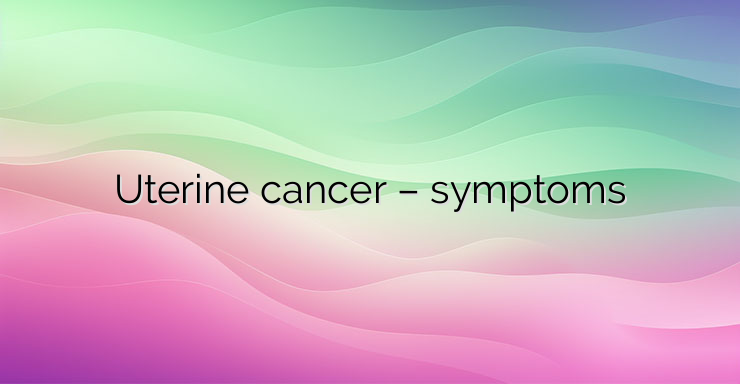Uterine cancer includes two types of cancer: endometrial carcinoma (more common) and uterine sarcoma. Uterine cancer is a general term that describes: Endometrial cancer that develops in the endometrium, the inner lining of the uterus. It is one of the most common gynecological cancers affecting the female reproductive system. Uterine sarcoma that develops in the myometrium, the muscular wall of the uterus. Uterine sarcomas are very rare. Are endometrial cancer and uterine cancer the same? Uterine cancer can refer to endometrial cancer, uterine sarcoma, or other rare forms of carcinoma that can occur in the uterus. But people often treat the terms “endometrial cancer” and “uterine cancer” as the same. This is because endometrial cancer is much more common than other types of cancer that can form in the uterine body. The endometrium is the inner lining of the uterus and changes during the menstrual cycle. A hormone called estrogen causes the endometrium to thicken in case of pregnancy. If pregnancy does not occur, the body produces less estrogen and more progesterone. When this happens, the lining of the endometrium is shed. Then the menstrual periods occur. Who is at risk for uterine cancer? There are several risk factors for endometrial cancer. Many of these are related to the balance between estrogen and progesterone. These risk factors include obesity, polycystic ovary syndrome, or estrogen intake. A genetic disorder known as Lynch syndrome is another risk factor unrelated to hormones. Risk factors include: Age. As you age, the likelihood of developing uterine cancer increases. Most uterine cancers occur after the age of 50. A diet high in animal fat. It can increase the risk of several types of cancer, including uterine cancer. Fatty foods are also high in calories, which can lead to obesity. Being overweight is a risk factor for uterine cancer. Family history. Some parents pass on genetic mutations (changes) for hereditary nonpolyposis colorectal cancer. This inherited condition increases the risk of a number of cancers, including endometrial cancer. Diabetes. This disease is often associated with obesity, a risk factor for cancer. But some studies suggest a more direct link between diabetes and uterine cancer. Obesity/Overweight. Some hormones are changed into estrogen by fat tissue, which increases the risk of uterine cancer. The greater the amount of adipose tissue, the greater the effect on estrogen levels Early menstruation. Menarche before the age of 12 increases the risk of uterine carcinoma. This is because the uterus has been exposed to estrogen for many years. Late menopause. Likewise, if menopause occurs after age 50, the risk also increases.Early pelvic radiation therapy. Radiation therapy to treat other types of cancer can damage cellular DNA. This damage can increase the risk of developing a second type of carcinoma. Estrogen replacement therapy. Some women are advised to use estrogen therapy to relieve menopausal symptoms. Receiving this type of therapy without progesterone puts patients at a higher risk of uterine cancer. The signs of uterine cancer can resemble those of many diseases. This is especially true for other conditions affecting the reproductive organs. If you notice unusual pain or bleeding, immediate consultation with a gynecologist is necessary. An accurate diagnosis is important so you can get the right treatment. Symptoms of endometrial cancer or uterine sarcoma include: Vaginal bleeding between periods before menopause; Vaginal bleeding or spotting after menopause, even mild; Pain in the lower abdomen or cramps in the pelvis; Rare white or transparent vaginal discharge, in the postmenopausal period; Extremely prolonged, heavy or frequent vaginal bleeding, in women over the age of 40. References: 1. Murali R, Davidson B, Fadare O, et al. High-grade Endometrial Carcinomas: Morphologic and Immunohistochemical Features, Diagnostic Challenges and Recommendations. Int J Gynecol Pathol. 2019;38 Suppl 1:S40-S63. 2. National Cancer Institute. Endometrial Cancer Treatment (PDQ®)–Health Professional Version. January 19, 2018. Accessed at www.cancer.gov/types/uterine/hp/endometrial-treatment-pdq/#section/all on January 30, 2019. 3. National Comprehensive Cancer Network, Clinical Practice Guidelines in Oncology (NCCN Guidelines ®), Uterine Neoplasms, Version 1.2019 — October 17, 2018. Accessed at www.nccn.org/professionals/physician_gls/pdf/uterine.pdf on January 30, 2019.Fadare O, et al. High-grade Endometrial Carcinomas: Morphologic and Immunohistochemical Features, Diagnostic Challenges and Recommendations. Int J Gynecol Pathol. 2019;38 Suppl 1:S40-S63. 2. National Cancer Institute. Endometrial Cancer Treatment (PDQ®)–Health Professional Version. January 19, 2018. Accessed at www.cancer.gov/types/uterine/hp/endometrial-treatment-pdq/#section/all on January 30, 2019. 3. National Comprehensive Cancer Network, Clinical Practice Guidelines in Oncology (NCCN Guidelines ®), Uterine Neoplasms, Version 1.2019 — October 17, 2018. Accessed at www.nccn.org/professionals/physician_gls/pdf/uterine.pdf on January 30, 2019.Fadare O, et al. High-grade Endometrial Carcinomas: Morphologic and Immunohistochemical Features, Diagnostic Challenges and Recommendations. Int J Gynecol Pathol. 2019;38 Suppl 1:S40-S63. 2. National Cancer Institute. Endometrial Cancer Treatment (PDQ®)–Health Professional Version. January 19, 2018. Accessed at www.cancer.gov/types/uterine/hp/endometrial-treatment-pdq/#section/all on January 30, 2019. 3. National Comprehensive Cancer Network, Clinical Practice Guidelines in Oncology (NCCN Guidelines ®), Uterine Neoplasms, Version 1.2019 — October 17, 2018. Accessed at www.nccn.org/professionals/physician_gls/pdf/uterine.pdf on January 30, 2019.


Leave a Reply